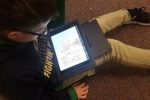Project-Based Learning – benefits for students

One of the biggest advantages that educational technology has brought to schools is the independence that students gain. Nowadays they have access to study materials anywhere anytime and can take leadership on their own learning process like never before.
Project-Based Learning is another outcome of introducing educational technology in the classroom. According to Edutopia Project-Based Learning is a dynamic classroom approach in which students actively explore real-world problems and challenges and acquire a deeper knowledge.
PBLWorks, adds that PBL “prepares students for academic, personal, and career success, and readies young people to rise to the challenges of their lives and the world they will inherit.”
Benefits of Project-Based Learning
Project-Based Learning can bring many benefits to the classroom. Since the model is based on working on one model for an extended period of time, students develop authentic and unique skills that are extremely valuable in today’s reality.
Students learn project management. When students engage in PBL they need to coordinate their work by themselves, thus, they gain management skills. Students are responsible for organizing the time, prioritizing tasks, and activities. Moreover, they assign roles to other group members and often manage and control the work of other colleagues. By acquiring project management skills, students grow as independent learners and researchers, become more responsible. In the future, they are able to assess how much time and effort they need to plan, create and submit a project.
Students are more engaged in learning. Nothing involves students more than a combination of independent work and technology. PBL, since gives them leadership on their own education, is one of the most engaging methods.
Students grow more empathic. Engaging students in a group project is a great way to prepare them for working in teams and being a part of the community. While cooperating, and discussing the project they learn understanding another’s feelings. Moreover, the PBL model sets students up to deepen relationships with their current classmates. It helps them to build a sense of security and stronger relationships with other children and educators, positioning them well for learning. Additionally, teamwork encourages tolerance and acceptance of others.
Students become problem solvers. Working on a particular issue enables students to explore new methods of gathering and analyzing the research materials. They learn to estimate which method will be the best in clarifying a particular problem, and how to conduct the process of answering the questions. With PBL students become excellent problem solvers since they think critically and know what techniques they need to use to explain the issue.
Students think divergently. Because of PBL, students improve divergent thinking (is a thought process or method used to generate creative ideas by exploring many possible solutions). By brainstorming, taking notes, exploring new topics, and using different sources of materials and information for their projects, students become more creative and generate more ideas on how to explain problems they work on.
Students become system thinkers. Focusing on one problem enables students to look at it from various perspectives. Combining all factors into one larger system where all pieces interrelate improves their thinking system. This approach contrasts with traditional analysis, which studies systems by breaking them down into their separate elements. By understanding that every component is a part of a greater system, students are able to model, illustrate, and predict system behavior.
Students become explorers. While working on a particular topic for a longer period, students investigate new branches of the subject and unintentionally discover unfamiliar areas. It lets them explore topics that would not be included in the lesson or left unmentioned in the textbooks. PBL allows students to explore new areas of basic topics. Students can recognize what part of the topics they like. It benefits in a way that they find an interesting problem and solve it beyond the homework.
Students are ready for the creative economy. Investigating a complex problem is for students an amazing opportunity to improve their creativity and problem-solving abilities. PBL prepares students for the creative economy that deals with the interface between economy, culture, technology, and social aspects. Students that work with PBL approach have strong critical thinking techniques and can connect economy events with the influence of technology and social aspects.
Students learn to take the risk. While designing the project students have a decision making power. They decide what part of the topic they want to include, what methods will be used, and how the project will be executed. Sometimes they need to take the risk and experiment. PBL is an excellent way to teach students about the consequences of their decision and a logical framework of events.
Wrap up
Project-Based Learning brings plenty of benefits in student’s education. Designing an independent project, or managing all the aspects of teamwork, can teach students many valuable skills that are necessary for their future careers.
Students when being taught with PBL methods acquire abilities to manage and organize their own learning process, become more emphatic, and are not afraid of taking the risk. Moreover, they develop critically and system thinking, as well as become explorers and better problem solvers.





